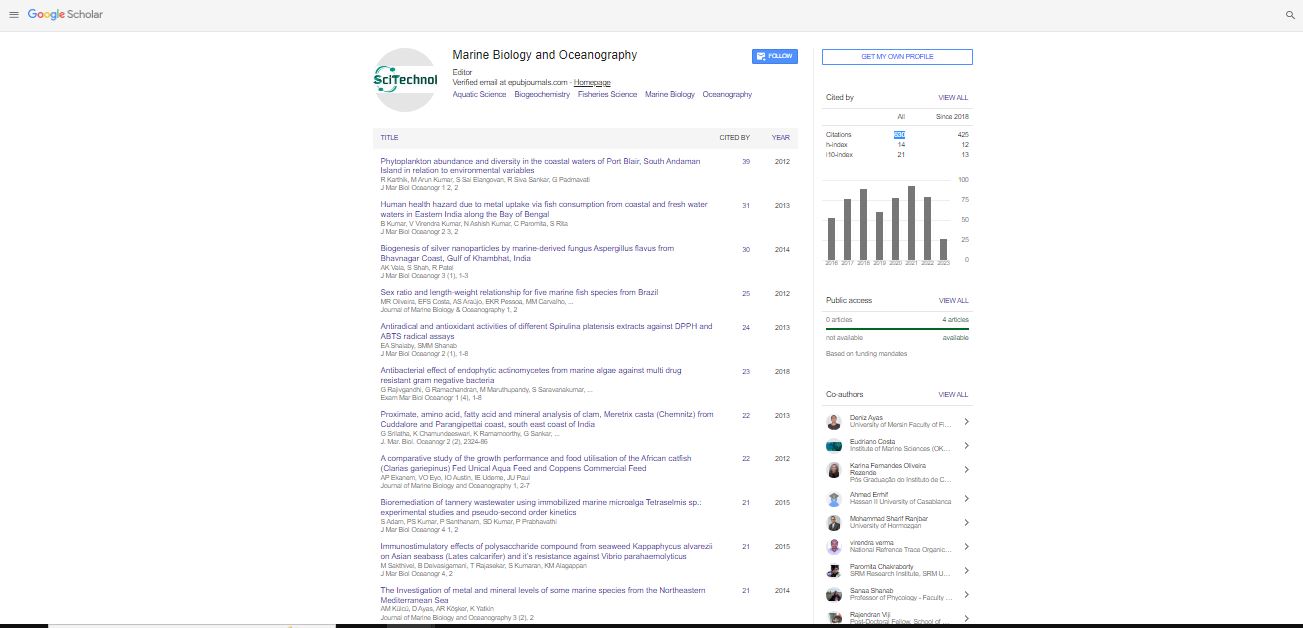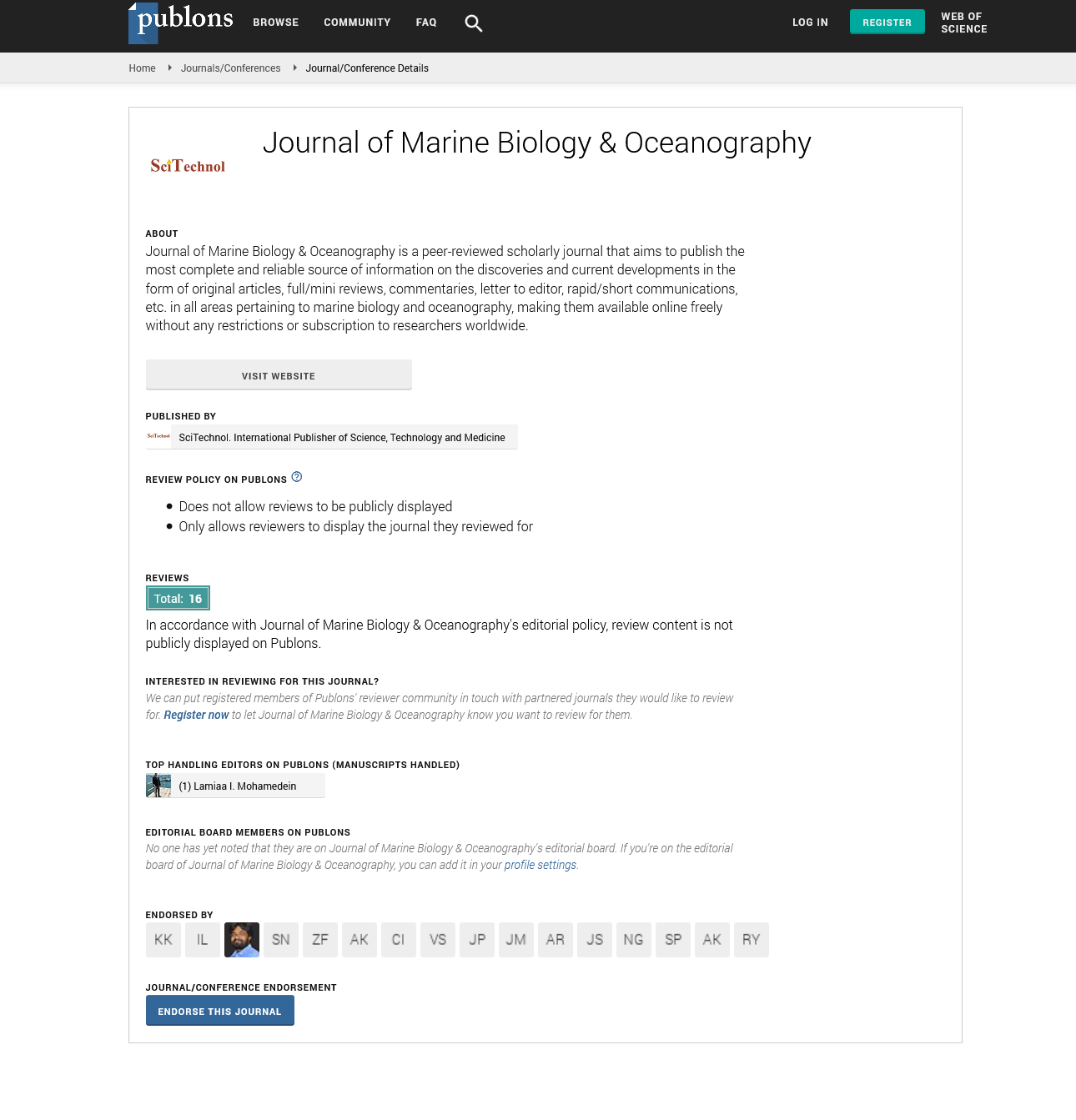Opinion Article, J Mar Biol Oceanogr Vol: 11 Issue: 4
Factors Affecting Domestic Marine Fish Consumption
Eugenio Fontana*
Griffith Business School, Griffith University, Gold Coast, Australia
*Corresponding author: Eugenio Fontana
Griffith Business School, Griffith University, Gold Coast, Australia
Email: fontanae@gmail.com
Received date: 14 March, 2022, Manuscript No. JMBO-22-62319;
Editor assigned date: 16 March, 2022, Pre QC No. JMBO-22-62319 (PQ);
Reviewed date: 28 March, 2022, QC No JMBO-22-62319;
Revised date: 07 April, 2022, Manuscript No. JMBO-22-62319 (R);
Published date: 15 April, 2022, DOI:10.4172/2324-8661.1000240
Citation: Fontana E (2022) Factors Affecting Domestic Marine Fish Consumption. J Mar Biol Oceanogr 11: 4.
Keywords: Marine Fish Consumption
Introduction
The Halda River is one of the important river of Chittagong districts which is one of the natural breeding ground of major carps in Bangladesh. The present study attempted on the physicochemical parameters and seasonal variability of the sediment of the Halda River. Soil Temperature, pH, texture, organic matter, organic carbon were analyzed by standard procedure at the laboratory of the institute of Marine Sciences, University of Chittagong. The range of the soil Temperature, pH, sand, silt, clay, organic matter and carbon were 27° C-32°C, 6.4-6.7, 54.43–41.00%, 20.70–29.70%, 20.92–29,10%, 3,29-4,355%, 1.112-2,520% respectively. Seasonal variation was observed with significant deviation during the monsoon due to heavy precipitation and heavy runoff from the upstream of Halda River. We need to take proper measure to conserve this unique aquatic natural body
Waste Assimilation Provision
Soil often called the skin of organic Earth, is a matter of decaying organic matter humus, minerals, liquids, and many countless living organisms. Soil covering the earth is a medium for plant growth and a means of water storage. Soil texture is one of the most stable properties and useful index of several other properties that determine the agricultural potential of soil. The Halda River is one of the most important rivers of Bangladesh. It is located in Chattogram. The Halda River rises from the Bangtail hill ranges in the Chattogram hill tracts and enter Chattogram district through Fatikchari upazila. It flows over Fayikchari, Haphazard, Ryazan, kowari, Nazi hat etc. oxbow-bends of Halda River are known to be prepared zone of major carps for breeding and spawning. The geographical location of the Halda River is between 22°56'07" to 22°42'11" N latitude and 91°37" to 92" E longitude. Halda is the third river of Chittagong district and has become the effecters of development providing fresh water supply, fish production, transportation and waste assimilation provision along with a great array of recreation and tourism option. Halda has a unique feature since it is the only natural breeding ground of major carps in Bangladesh (Kabhir et al., 2013). Spawning area of this river extended from Gadara to Madunaghat where a total of 1100 egg collectors and 200 fishermen catch fish throughout the year (Islam, 2009).
The Halda in one of the important rivers in Bangladesh in Chittagong district. It is located between 22°56'07" to 22°42'11" N latitude and 91°37" to 92" E longitude. It is considered as the natural breeding ground of fish. Its source of origin and water boundary concluded within Bangladesh. The Halda River starts from the north Chittagong hill tracts area and flows into the Karnafully River Samples were collected from two stations like Modunaghat Bridge and Ramdas Hut. The exact location is marked. A dry ignited porcelain crucible was weighed. Then about 2gm of soil was taken in the crucible and weighed again. Then the sample was dried in an oven at 105°C. The oven dried sample was ignited in a muffle furnace at 550°C for 2 hours. Afterwards the crucible was transferred to desiccators to cool up to room temperature. The crucible and the ignited soil were weighted again. The net loss in weighed is the organic matter of the soil obtained.
In the laboratory all soil sample were mixed thoroughly in equal portion to prepare a composite portion. All soil samples were air dried at room temperature and then powdered, and passed through a 5mm mesh sieve separately. Finally soil sample were over dried at 60°C for 24 hours.
Soil texture is a classification instruments used both in the field and laboratory to determine soil classes based on their physical texture. The relative size of the soil particles is expressed by the term texture which refers to the fineness or coarseness of the soil.
25gm oven dry soil (60°C) was taken in a 500ml beaker and 50ml distilled water was added, the contents were stirred thoroughly with a glass rod for half an hour, then 10ml IN NaOH solution was added stirred thoroughly and the contents were transferred quantitatively into a homogenized cup with repeated washing, the material was thoroughly homogenized and transferred to a 1000ml sedimentation cylinder, the volume was made up to the mark with distilled water, this was stirred thoroughly to prepare a uniform suspension the suspension was allowed to settle and reading with a Bouzoukis soil hydrometer and a thermometer were taken exactly after 4 minutes and 2 hour, a similar blank was run without soil but with the addition of 10ml IN NaOH solution to distilled water. In the laboratory all soil sample were mixed thoroughly in equal portion to prepare a composite portion. All soil samples were air dried at room temperature and then powdered, and passed through a 5mm mesh sieve separately. Finally soil sample were over dried at 60°C for 24 hours.
Various industrial activities, commercial activities, power plant discharge, human wastes untreated effluents and pollutants are responsible for the deterioration of water quality and sediment nature of study area. Physicochemical parameters and soil texture were maintaining a seasonal trend, which are remarkable to our subtropical coastal region. The amount of organic carbon in the study river found liberally moderate. It also varied monthly throughout the year. So the mitigation should be taken immediately to prevent pollution and protect aquatic resource mesh sieve separately. Finally soil sample were over dried at 60°C for 24 hours.
Soil Texture Classification
Soil texture is a classification instruments used both in the field and laboratory to determine soil classes based on their physical texture.The relative size of the soil particles is expressed by the term texture which refers to the fineness or coarseness of the soil. A dry ignited porcelain crucible was weighed.
 Spanish
Spanish  Chinese
Chinese  Russian
Russian  German
German  French
French  Japanese
Japanese  Portuguese
Portuguese  Hindi
Hindi 
